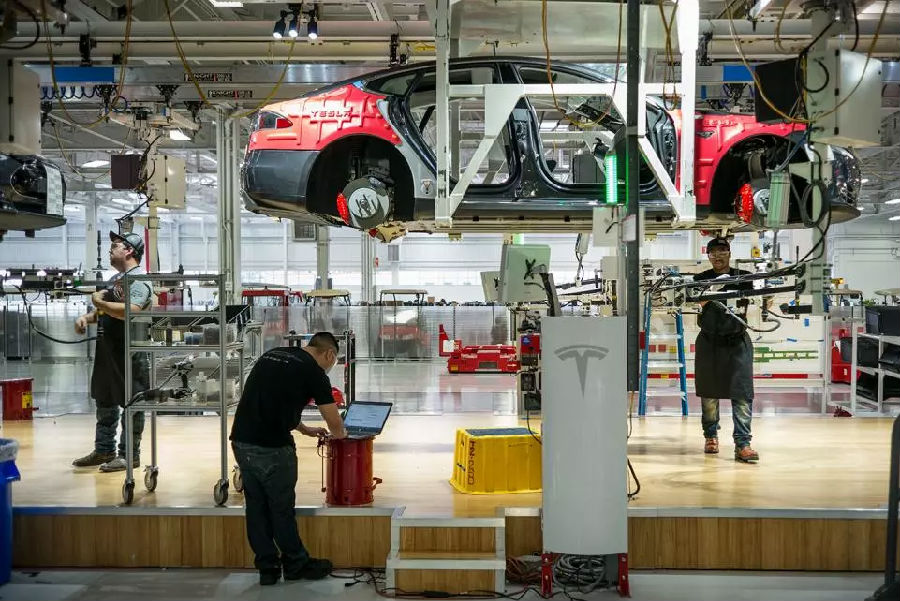成功的高成本
Even if Musk fails to turn Tesla into a mass-market carmaker, its profits in the luxury market and its many innovations may serve as the catalysts for an ecosystem of new transportationcompanies and initiatives that will go on to thrive and flesh out his vision for a worldwide conversion to electric vehicles.
即使馬斯克不能使特斯拉成為面向大眾市場的汽車制造商,其在奢侈品市場的利潤和許多創新,還是可能催化新交通公司生態系統,并振興充實電動汽車風靡全球的愿景。
“Thanks partly to Elon, the supply chain and consumer acceptance are maturing,” says Evelozcity’s Kindler. “Because of that, it’s a safe bet that electric cars are coming to the masses.”
“部分得益于伊隆·馬斯克,供應鏈和消費者接受度趨于成熟,” Evelozcity公司的金德勒說道。“正因如此,電動汽車向大眾普及是一個安全賭法。”
The rub, of course, is that the better things look for Tesla, or companies that pattern themselves after Tesla, the worse they look for the future of American manufacturing jobs. Musk has made clear he’s aiming to do away with workers. He’s publicly referred to his goal of turning Tesla’s factories into “a machine that builds machines,” adding that he’s going to keep piling on the automation until the assembly line looks like “an alien dreadnought.” He promised last year to speed up his production rate by a factor of 20—not by hiring but by doubling the number of robots in his factories to nearly 1,000. According to analysts, Tesla, on average, has already invested twice as much in robots per car produced than other car manufacturers.
當然,問題是特斯拉或那些效仿特斯拉的公司情況越好,美國制造業就業崗位的前景就越悲觀。馬斯克已經明確表示,他的目標是替代工人。他曾公開表示,他的目標是把特斯拉的工廠變成“一臺制造機器的機器”,并補充說,他將繼續推進自動化,直到裝配線看起來像“一艘外星人的重炮戰艦”。去年,他承諾將生產速度提高20倍——不是通過雇傭,而是通過將工廠里的機器人數量增加一倍,達到近1000臺。分析師表示,平均而言,特斯拉在每輛汽車上投入的機器人數量是其它汽車制造商的兩倍。
And the robots he’s buying are far more sophisticated than those you typically find in auto factories, which do the same simple action over and over again. Tesla’s bots can be programmed to perform a number of different, more complex tasks, even working together in groups as large as 15 on a single car. It is the first automaker ever to let robots handle final assembly of the cars, a complex set of tasks that is the last bastion of human labor in auto factories. Analysts have pointed out that at the assembly line speeds that Musk has said he’s shooting for, the presence of even a single human would be a hindrance, if not an outright hazard.
他購買的機器人遠比你通常在汽車工廠看到的復雜得多,汽車工廠一遍又一遍地做著同樣簡單的動作。通過編程,特斯拉的機器人可以執行許多不同的、更復雜的任務,甚至可以在一輛汽車上以多達15個小組的規模一起工作。這是有史以來第一家允許機器人完成汽車總裝的汽車制造商,而汽車總裝是汽車工廠人類勞動的最后堡壘。分析人士指出,如果不考慮直接危害,要達到馬斯克聲稱追求的生產線速度,即使一個人力都會成為阻礙。
So far, the effort to hyper-roboticize Tesla’s factories has been bumpy. Automation glitches are largely behind some of the big delays in Model 3 production. “Humans are underrated,” Musk said after failing to hit targets earlier this year. Which is not to say that there is any chance he will give up on his longer-range goal of eliminating workers. It’s no mystery why: Volkswagen has calculated that its robots work for less than $6 an hour, with all costs figured in, compared with $47 an hour in total costs for a human worker.
迄今為止,對特斯拉工廠進行超級機器人化的努力并不順利。在Model 3的生產過程中,自動化故障在很大程度上是延遲的原因。“人類被低估了,”在今年早期未能完成目標后馬斯克如是說道。但這并不是說他有可能放棄長期的裁員目標。原因并不神秘:大眾汽車計算出,其機器人每小時的工作成本不到6美元,所有成本都計入在內,人類工人每小時的總成本為47美元。

If Musk succeeds in getting rid of humans in the car factory, he’ll likely be able to leverage that achievement, doing the same for the production of the semitrucks he’s starting to build, as well as for his already heavily automated battery, solar panel and space ventures (plus any future industry-killer companies that he has yet to dream up). And Tesla’s self-driving cars could mean the loss of another layer of employment opportunities: human drivers, a job currently held by roughly 3 percent of the American working population, including 3.5 million truck drivers.
如果馬斯克成功用機器替代了汽車工廠里的人工,他很可能會同樣運用于正開始建造的電動半掛卡車生產,還會運用于已經高度自動化的電池、太陽能電池板和太空冒險(以及其尚未構想出的任何未來“行業殺手”公司)。而特斯拉的自動駕駛汽車可能意味著另一層就業機會的喪失:人類司機,目前約有3%的美國工作人口從事這項工作,其中包括350萬卡車司機。
譯文由可可原創,僅供學習交流使用,未經許可請勿轉載。












